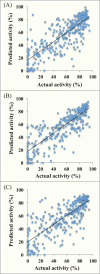SMEpred workbench: A web server for predicting efficacy of chemicallymodified siRNAs
- PMID: 27603513
- PMCID: PMC5100349
- DOI: 10.1080/15476286.2016.1229733
SMEpred workbench: A web server for predicting efficacy of chemicallymodified siRNAs
Abstract
Chemical modifications have been extensively exploited to circumvent shortcomings in therapeutic applications of small interfering RNAs (siRNAs). However, experimental designing and testing of these siRNAs or chemically modified siRNAs (cm-siRNAs) involves enormous resources. Therefore, in-silico intervention in designing cm-siRNAs would be of utmost importance. We developed SMEpred workbench to predict the efficacy of normal siRNAs as well as cm-siRNAs using 3031 heterogeneous cm-siRNA sequences from siRNAmod database. These include 30 frequently used chemical modifications on different positions of either siRNA strand. Support Vector Machine (SVM) was employed to develop predictive models utilizing various sequence features namely mono-, di-nucleotide composition, binary pattern and their hybrids. We achieved highest Pearson Correlation Coefficient (PCC) of 0.80 during 10-fold cross validation and similar PCC value in independent validation. We have provided the algorithm in the 'SMEpred' pipeline to predict the normal siRNAs from the gene or mRNA sequence. For multiple modifications, we have assembled 'MultiModGen' module to design multiple modifications and further process them to evaluate their predicted efficacies. SMEpred webserver will be useful to scientific community engaged in use of RNAi-based technology as well as for therapeutic development. Web server is available for public use at following URL address: http://bioinfo.imtech.res.in/manojk/smepred .
Keywords: Chemically modified siRNA; RNAi; cm-siRNAs; efficacy prediction; siRNA; siRNA modifications; small interfering RNA; webserver.
Figures



Similar articles
-
siRNAmod: A database of experimentally validated chemically modified siRNAs.Sci Rep. 2016 Jan 28;6:20031. doi: 10.1038/srep20031. Sci Rep. 2016. PMID: 26818131 Free PMC article.
-
VIRsiRNApred: a web server for predicting inhibition efficacy of siRNAs targeting human viruses.J Transl Med. 2013 Dec 11;11:305. doi: 10.1186/1479-5876-11-305. J Transl Med. 2013. PMID: 24330765 Free PMC article.
-
ASPsiRNA: A Resource of ASP-siRNAs Having Therapeutic Potential for Human Genetic Disorders and Algorithm for Prediction of Their Inhibitory Efficacy.G3 (Bethesda). 2017 Sep 7;7(9):2931-2943. doi: 10.1534/g3.117.044024. G3 (Bethesda). 2017. PMID: 28696921 Free PMC article.
-
Designing highly active siRNAs for therapeutic applications.FEBS J. 2010 Dec;277(23):4806-13. doi: 10.1111/j.1742-4658.2010.07903.x. FEBS J. 2010. PMID: 21078115 Free PMC article. Review.
-
Chemical modification of siRNA.Curr Protoc Nucleic Acid Chem. 2009 Dec;Chapter 16:Unit 16.3. doi: 10.1002/0471142700.nc1603s39. Curr Protoc Nucleic Acid Chem. 2009. PMID: 20013783 Review.
Cited by
-
Leveraging Artificial Intelligence for Synergies in Drug Discovery: From Computers to Clinics.Curr Pharm Des. 2024;30(28):2187-2205. doi: 10.2174/0113816128308066240529121148. Curr Pharm Des. 2024. PMID: 38874046 Review.
-
Functional features defining the efficacy of cholesterol-conjugated, self-deliverable, chemically modified siRNAs.Nucleic Acids Res. 2018 Nov 16;46(20):10905-10916. doi: 10.1093/nar/gky745. Nucleic Acids Res. 2018. PMID: 30169779 Free PMC article.
-
i-DENV: development of QSAR based regression models for predicting inhibitors targeting non-structural (NS) proteins of dengue virus.Front Pharmacol. 2025 Jun 26;16:1605722. doi: 10.3389/fphar.2025.1605722. eCollection 2025. Front Pharmacol. 2025. PMID: 40642016 Free PMC article.
-
Systematics for types and effects of RNA variations.RNA Biol. 2021 Apr;18(4):481-498. doi: 10.1080/15476286.2020.1817266. Epub 2020 Sep 20. RNA Biol. 2021. PMID: 32951567 Free PMC article.
-
Role of Artificial Intelligence in Drug Discovery to Revolutionize the Pharmaceutical Industry: Resources, Methods and Applications.Recent Pat Biotechnol. 2025;19(1):35-52. doi: 10.2174/0118722083297406240313090140. Recent Pat Biotechnol. 2025. PMID: 39840410 Review.
References
-
- Gaglione M, Messere A. Recent progress in chemically modified siRNAs. Mini Rev Med Chem 2010; 7:578-95; PMID:20500149; http://dx.doi.org/10.2174/138955710791384036 - DOI - PubMed
-
- Kurreck J. RNA interference: from basic research to therapeutic applications. Angewandte Chemie (International ed in English) 2009; 48:1378-98; PMID:19153977; http://dx.doi.org/10.1002/anie.200802092 - DOI - PMC - PubMed
-
- Tafer H, Ameres SL, Obernosterer G, Gebeshuber CA, Schroeder R, Martinez J, Hofacker IL. The impact of target site accessibility on the design of effective siRNAs. Nat Biotechnol 2008; 26:578-83; PMID:18438400; http://dx.doi.org/10.1038/nbt1404 - DOI - PubMed
-
- ElHefnawi M, Hassan N, Kamar M, Siam R, Remoli AL, El-Azab I, AlAidy O, Marsili G, Sgarbanti M. The design of optimal therapeutic small interfering RNA molecules targeting diverse strains of influenza A virus. Bioinformatics 2011; 27:3364-70; PMID:21994230; http://dx.doi.org/10.1093/bioinformatics/btr555 - DOI - PubMed
-
- Behlke MA. Progress towards in vivo use of siRNAs. Mol Ther 2006; 13:644-70; PMID:16481219; http://dx.doi.org/10.1016/j.ymthe.2006.01.001 - DOI - PMC - PubMed
MeSH terms
Substances
LinkOut - more resources
Full Text Sources
Other Literature Sources
